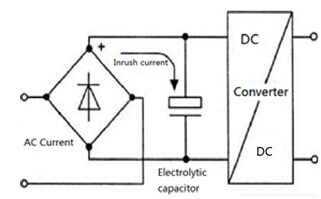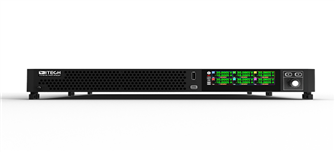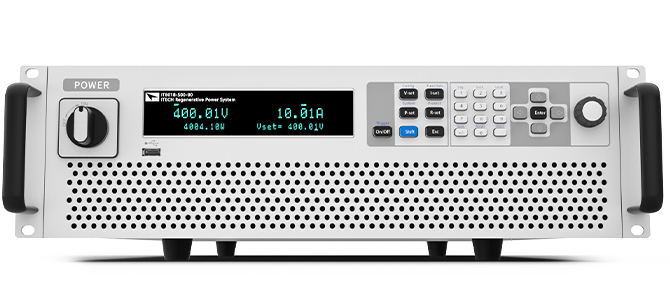Generally speaking, CV and CC are two types of operation modes of DC power supplies. The two operation modes correspond to two internal loops (CV control loop and CC control loop). Traditional power supplies adopt CV as the high priority. The disadvantage of traditional power supplies is the overshoot current which can’t meet the testing requirements in critical occasions. To conquer the demanding testing requirements existing for a long time in various applications, ITECH developed an innovative industry-leading CV & CC priority concept. The IT6500 is available for high-speed test applications without overshoot. Users can choose their desired output mode. Voltage high-speed mode or current no overshoot mode by choosing the loop response speed and loop operation mode.

Figure1. Parallel and serial connection schematic of control loop
Case Analysis: LED lamp test, Laser test etc.
For traditional power supplies, once the current reached setting current, they can’t quickly detect and suppress the overshoot current due to the slow CC loop and the lower priority. Figure2 is a LED lamp test result which tested by a traditional power supply, from the current and voltage waveform captured by an oscilloscope, we can see the overshoot clearly.

Figure2.LED lamp test result which is tested by a traditional power supply
IT6500C series is available for operation mode priority setting. Users can chose the desired output mode through IT6500C series menu. Take LED lamp test as an example, set CC mode as high priority, make the power supply change into CC mode to suppress the large current surge at turn on and protect DUTs, e.g. LED lamp or lasers etc. Figure3 is a LED lamp test result which tested by IT6500C power supply when CC mode is high priority, from the current and voltage waveform captured by an oscilloscope, we can see there is no overshoot current.

Figure3.LED lamp test result which is tested by IT6500C power supply
Case Analysis:IT6500C series solutions for abnormal start and high cost problems in DC-DC module testing
Huge capacitance which exists at power module input terminal causes large current surge at turn-on instant. The inrush current makes the voltage of DC module to be lower and comes into CC limiting mode. Lower voltage input will cause under voltage protection of DC module, even can't start normally.

Figure4.DC-DC Module circuit schematic diagram
For example, when DC voltage input is 300V, if the instant inrush current is 30A, normal operation current is 10A, then only 9kW power supply can ensure the input voltage to be stable at 300V. The solution above resolved the stand-up inrush current and ensured the input voltage stability but greatly added the testing cost. In fact except the mS level inrush current testing requires 9kW power supply, 3kW (300V*10A) is enough for normal operation testing requirements.
Then, how to effectively save the testing cost? When we analyze the voltage drop reasons, the main reason leading to voltage drop is the inrush current which created at start-up instant and made the power supply start current limiting protection.
The following figure is the testing waveforms of DC-DC module repeatedly starting with under voltage from the low power of DC power source in communication power source module testing.

Blue is for DC-DC module input current waveform
Red is for the voltage waveform of DC-DC input module terminal and also indicates the output voltage waveform of the power source
Figure5.Testing waveforms of DC-DC module in certain status
We can see from figure 5, the glitch on the blue line is the inrush current created at starting instant. The inrush current can lead voltage of the power source to be lower and let DC-DC module enter under voltage protection, also the starting will be abnormal.
Thus, if we set the CC loop response speed as slow, that means it will be not sensitive to instant high current and will delay to enter CC loop status. That can effectively avoid the inrush current and make the voltage will not drop.Then you can buy a small DC power supply for testing. For example, adopt IT6500C series DC power supply, the control loop can be set to CC as the LOW gear, delay the response speed of inrush current in the starting instant ,keep the power supply in CV mode and provide stable operation voltage. After the inrush current, device can start as normal, as figure 6 below.

Green is for the input current waveform of DC-DC module.
Yellow is for the input voltage waveform of DC-DC module and also it is the output voltage waveform of the power supply.
Figure6.Testing waveforms with no inrush current by IT6500C seriescurrent waveform of DC-DC module
Take IT6522C (80V/120A/3000W) as an example, provide power to DC-DC mode, operating current is 60A, operating voltage is 45V, but the inrush current will be 150A at the starting instant. For enough to stand up the inrush current and do not lead to the under voltage protection of the device. Normally it requires to choose 45V*150A=6750W power supply, high cost. The CV/CC priority function can effectively avoid the inrush current and ensure the stable output, 3kW power supply is enough to meet the test requirements, which greatly saves the cost.
IT6500C is the latest DC power supply series launched by ITECH. Besides the CC/CV priority which can be applied in critical inrush current testing, IT6500C provides seamless switching between two quadrants, built-in automotive electronic standard testing curves, solar panel I-V curve simulation function, paralleling& automatic current assigning, variable output impendence function etc. Combined with power dissipater, the current sinking capacity of IT6500C can be extended to 300% (max.90kW). Conclusion, as a two quadrants high speed and high power DC power supply series, the multifunction feature of IT6500C will provide a new level of testing performance to the engineers in automotive electronics, battery etc.





































































 PV/Energy Storage
PV/Energy Storage
 Electric Vehicle
Electric Vehicle
 Battery
Battery
 Battery recycling
Battery recycling
 Semiconductor / IC
Semiconductor / IC
 Power Supply
Power Supply
 Industrial Electronics
Industrial Electronics
 Research/Education/Others
Research/Education/Others
 Medical Electronics
Medical Electronics
 Automotive Electronics
Automotive Electronics
 IoT
IoT










